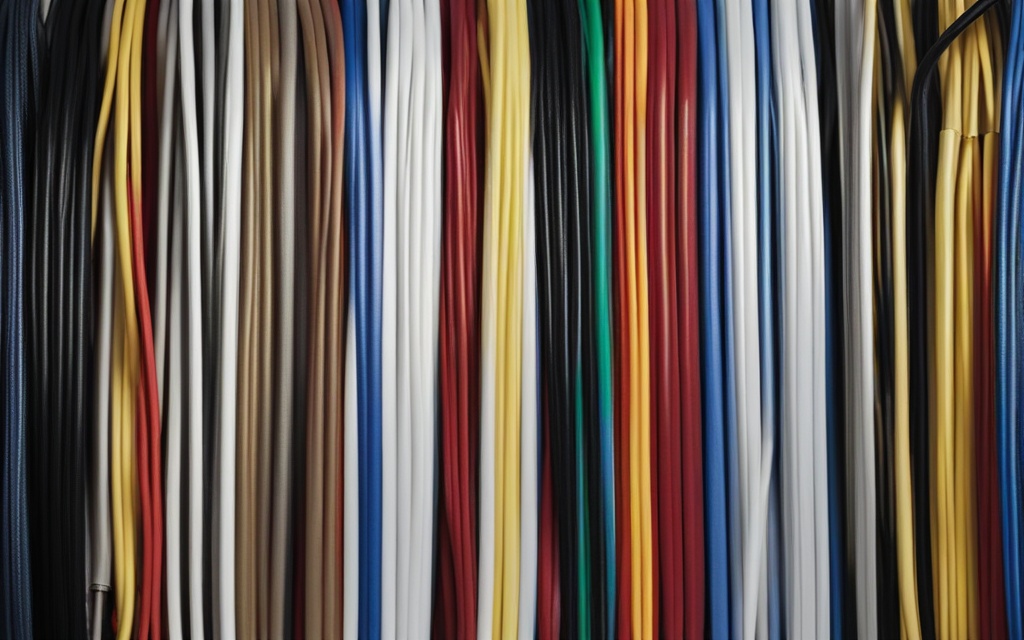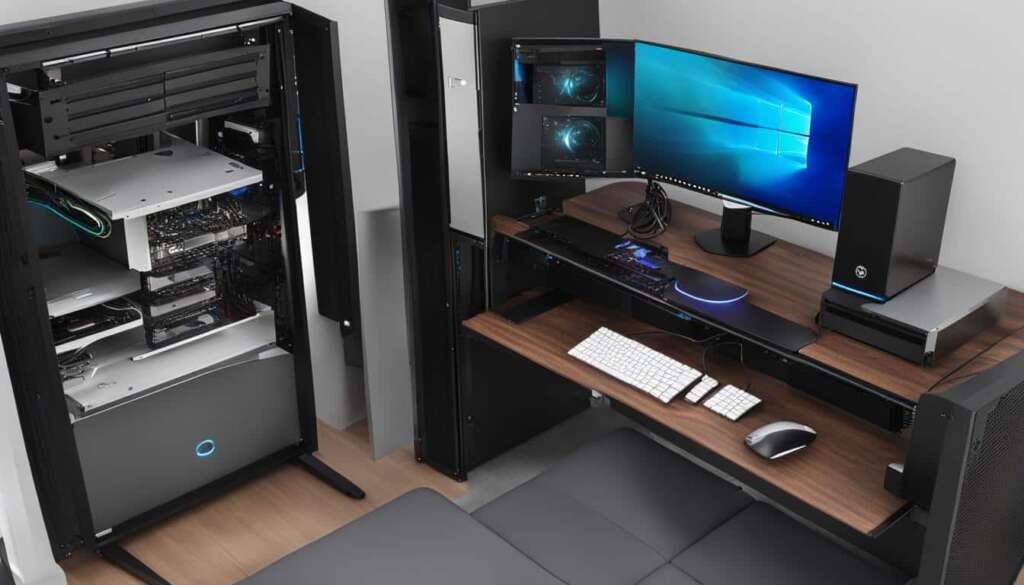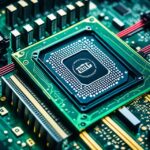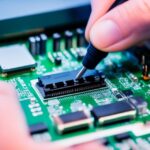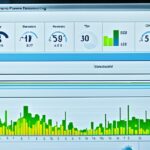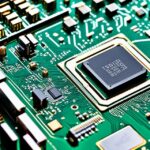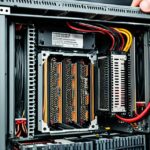Table of Contents
Building a new computer is an exciting journey. However, knowing the cable requirements is crucial for a successful PC build. The correct cables make sure every component gets power and connects well, ensuring your PC works at its best.
Power Cables: Ensuring Adequate Power for Your Components
Power cables are vital for sending electrical power to your PC parts. Most power supplies are clearly labelled. This helps avoid any mix-ups when connecting1. Graphics cards may need one to three 6 or 8-pin PCI Express connectors for extra power1. Also, whilst the latest NVMe and M.2 drives don’t need external power, older SATA SSDs or HDDs demand a SATA power cable each1.
Managing Power Cables for a Neat and Efficient Build
Keeping cables neat and tidy is essential. SATA cables link SATA SSDs and HDDs to the motherboard’s SATA port1. This helps data and power move efficiently within your PC. Using cable ties or other solutions is advised to secure cables and keep them out of the way.
Data Cables: Connecting Your Storage Drives
Data cables are key for linking your storage and accessories to the motherboard. SATA cables are for SATA SSDs and HDDs1. USB-C cables allow for quick data transfers and can power devices like phones or external drives.
Video Cables: Connecting Your PC to a Monitor
Video cables connect your PC to a monitor, giving you clear visuals. HDMI 2.1 is great for 4K video at up to 120Hz1. It handles audio too. DisplayPort 1.4 is even better for high-end screens, supporting 8K at 165Hz or a 1080p screen at 900Hz1.
Conclusion
Knowing what cables your PC build needs is vital. From power to data and video cables, each is essential for top performance. Choosing and managing your cables well improves your setup and your computing joy.
Key Takeaways:
- Power cables are key for powering PC parts, with graphics cards needing extra PCI Express connectors1.
- Data cables like SATA and USB-C hook up storage drives and peripherals to the motherboard1.
- HDMI and DisplayPort are top choices for linking PCs to monitors, supporting high resolutions and refresh rates1.
- A tidy and efficient build is achieved through proper cable management1.
- Picking and effectively managing the right cables ensures great performance and a smooth computing experience1.
Power Cables: Ensuring Adequate Power for Your Components
Power cables are vital for delivering the needed power to each PC component. They make sure your PC performs at its best. Knowing the different power cables and what they do is crucial when building a reliable PC.
Motherboard 24-pin Connector – Powering Key Components
The motherboard 24-pin connector powers the chipset and PCIe slots. Located near the CPU socket, it’s a must for most motherboards2. It ensures your system runs smoothly.
CPU Power Cables – Meeting Power Demands
As modern CPUs need a lot of power, they get extra from 4/8-pin connectors2. These “CPU” labeled connectors help keep CPU performance steady.
Graphics Card Power – Beyond the PCIe Slot
High-performance graphics cards need more power than the PCIe slot offers2. They get it through 6/8-pin PCIe connectors. The type of connector depends on the graphics card’s power needs. Options include 6, 8, 6+6, 8+6, and 8+8 pins.
Modular Power Supplies – Flexible Cable Selection
Modular power supplies let you choose which cables to use. This makes cable management easier and improves airflow2. You can pick the right cables for your components, reducing clutter.
Other Power Connectors
There are other power connectors in PC builds besides those for the motherboard, CPU, and graphics card.
- The SATA power connector is mostly for SSDs and hard drives. It can also power devices like RGB hubs and fan controllers23.
- The 4-pin Molex connector, once common, is now less used but still powers accessories like water cooling pumps24.
Power Calculations and Efficiency Ratings
It’s vital to know how much power your PC needs. Using PSU Wattage Calculators can help you figure out the right power supply2. High-end systems with custom cooling and dual GPUs often need more power.
Efficiency ratings show how good a power supply is. The 80 Plus rating system has different levels like Bronze and Platinum23. The higher the rating, the less power is wasted, reducing heat outputs.
| Power Connectors | Supported Max Wattage (Voltage Rail) | Reference |
|---|---|---|
| Motherboard 24-pin | Varies, often up to 250W (3.3V, 5V, 12V) | 2 |
| CPU Power – 4/8-pin | Varies, often up to 150W (12V) | 2 |
| Graphics Card Power – 6/8-pin PCIe | Varies, often up to 300W (12V) | 2 |
| SATA Power | Varies, often up to 54W (3.3V, 5V, 12V) | 23 |
| 4-pin Molex | Varies, often up to 90W (5V, 12V) | 24 |
Choosing the right power cables is crucial for your PC. It helps avoid issues and ensures your PC runs well. A good power supply with the right cables paves the way for upgrades too.
Managing Power Cables for a Neat and Efficient Build
Keeping your cables tidy is key to a neat PC setup. A clean design not only looks good but helps your computer run better. This is because tidy cables improve airflow. Good airflow is needed for cooling and performance. So, managing your cables well means your computer will perform better and be easier to upgrade later on.
Handling power cables requires care. Using extension cables for power supplies is a smart move.These extensions help by lengthening your power cables. This makes your setup neater and reduces clutter5.
Bundling cables is a basic part of managing them. Cable ties are perfect for this task. You can choose from zip ties, velcro straps, or cable sleeves. These items keep your cables together, avoiding a tangled mess. This makes it simpler to route them neatly inside your computer case5.
It’s important to plan your cable layout before building. Imagine how you want everything arranged. Think about the tricky spots for cables. With a good plan, you’ll know what you need to manage your cables well5.
Organizing cables by their use is a good strategy. By grouping them, it’s easier to keep track of what goes where. Using cable ties and routing cables through specific paths can keep your setup tidy5.
For gamers, going wireless is a great way to cut down on cable clutter. Wireless keyboards, mice, headsets, and speakers mean fewer cables to manage. This makes for a cleaner gaming setup5.
In stationary setups, using a PC holder under the desk can keep things tidy. It’s a neat way to store your cables. This not only looks good but also helps with airflow and prevents tangling. It’s ideal for a minimalist look5.
Using these tips, you can create a PC that’s both good-looking and efficient. Remember, good cable management takes time. Be careful with your cables to get the best out of your setup. A tidy cable system means better airflow, easier upkeep, and a sleek look for your PC.
Data Cables: Connecting Your Storage Drives
Data cables are just as important as power cables for linking your storage drives to your computer. These cables make sure that data moves smoothly, letting you get and save files easily. There are different types of data cables, depending on your storage drives.
SATA Cables for SATA SSDs and Hard Drives
For SATA SSDs or hard drives, SATA cables are needed. They connect to the SATA ports on your computer’s motherboard. These cables have L-shaped connectors that make installation easy. They ensure a stable and fast connection for your devices, enabling quick data transfer.
SATA Power Cables for Powering Your Drives
You’ll also need SATA power cables for your SATA drives. These cables can power several drives from one source. They make sure your drives have the power they need to work well and access data fast.
Modern Storage Drives and External Connections
Modern drives like NVMe SSDs and M.2 drives don’t need external power cables. They get power straight from the motherboard. This makes setting them up simpler and reduces the mess of cables in your computer.
For external storage, you might need a different type of cable. Modern exterior SSDs usually use USB-C cables. For the best results, especially with drives that support USB4 or Thunderbolt 4, a USB-C to USB-C cable is advised.
Understanding the various data cables is crucial. Proper setup and fixing problems ensures smooth data transfer.
High-capacity HDDs are great for photographers, video editors, and businesses. They offer a lot of storage for a good price6.
High-performance SSDs are perfect for gamers, graphic designers, and performance-focused users. They are fast and reliable6.
Hybrid drives mix SSD speed with HDD storage. They offer a good balance of cost, performance, and space6.
Modern external hard drives usually have USB 3.0 or Thunderbolt ports. They suit various computers and needs6.
Installing an internal hard drive involves attaching it, connecting cables, and the system detecting it on restart6.
To fix common connection problems, check USB or SATA links, try different ports, and update drivers if needed6.
Maintaining Your Hard Drives and Valuable Data
Keeping your hard drives in good shape is key to their life and data safety. Here’s what to do:
- Back up your data often to protect against loss or failure.
- Check disks regularly to spot and fix errors.
- Defrag HDDs to improve their performance and storage.
- Switch off drives when not used to save power and reduce wear.
- Keep antivirus updated to guard against malware or viruses.
By sticking to these practices, you can maintain your hard drives well and protect your data.
Choosing the right cables is key for connecting storage drives. SATA cables are used inside, while USB-C cables are for external drives. Knowing your cables and how to install and maintain them helps keep drive connections smooth and data safe.
Video Cables: Connecting Your PC to a Monitor
Connecting your PC to a display is vital for a great viewing experience. Video cables are essential in this process. You can choose from HDMI, DisplayPort, and USB-C7 based on your needs and gadget compatibility.
HDMI cables are great because they support both video and audio. They can handle up to 4K resolution7. You’ll find them in PCs, laptops, gaming consoles, and more. Their plug-and-play ability makes them a popular choice.
DisplayPort cables are top-notch for high-end use. They beat HDMI in resolution and refresh rates, perfect for pros in graphic design and video editing. They can even handle 8K at 165Hz8. You’ll see DisplayPort in quality monitors and graphics cards.
USB-C cables are known for their versatility and are common in laptops and phones. They can handle video too. Their performance varies, from USB 3.2 2×2 to Thunderbolt 3 or 48. They’re ideal for those who want one cable for everything.
Picking between HDMI and DisplayPort depends on what you need. For compatibility, HDMI is great. DisplayPort is for those needing high specs, like multiple monitors. USB-C is all about convenience for modern gadgets. Your choice should match your need and equipment capabilities78.
Typically, you’ll need two cables to connect a monitor to a PC: one for power and one for data. The type of data cable depends on both the computer and monitor ports. Choices include DVI, HDMI, DP, and USB-C. HDMI is recommended for a quality display. If the ports don’t match, converters or different cables might be needed. For more details on video cables, check out this resource7.
Conclusion
Knowing what cables your PC needs is key to building it right. About 80% of people who build their own PCs must choose power supply cables carefully. They need the right wattage and connectors for their computer’s main parts9. This ensures the PC works well and efficiently.
It’s also crucial to manage your cables well. Neat cable management makes your PC look good and keeps it cool by allowing air to flow. Since custom PC cases usually have a couple of USB ports, you might need extra USB cables for more devices9.
For video hook-ups, different cables are used. HDMI cables are popular for computers and entertainment setups10. DisplayPort cables provide high-quality video and sound, and they’re great for modern monitors10. And if you have an old monitor or projector, you’d likely use a VGA cable10.
Using the right PC cables is fundamental for a well-working setup. There are power cables for energy, data cables for your storage, and video cables for screens. With good research, you can figure out exactly what your custom PC needs910.
FAQ
What cables do I need for a PC build?
You’ll need three types of cables for a PC build. These are power cables, data cables, and video cables. They help connect everything correctly and make sure it works well.
What is the most important power cable in a PC?
The 24-pin connector cable for the motherboard is key. It powers the motherboard and all its parts.
Are there additional power cables required for the processor and graphics card?
Yes, the CPU and graphics card may need extra power cables. These are often six or eight-pin PCI Express power connectors.
How can I manage power cables for a neat and efficient build?
Use sleeved extension cables for your power supply. Bundle wires together with velcro zip ties. Hide any loose cables in your case’s corners and notches.
What data cables do I need for connecting storage drives?
You need SATA cables for connecting SATA SSDs and hard drives to the motherboard. SATA power cables are also needed to power these drives.
What type of video cables should I use to connect my PC to a monitor?
HDMI, DisplayPort, and USB-C are the most common video cables needed. The best choice depends on what your graphics card and monitor support.
Why is understanding cable requirements important for a PC build?
Knowing about cables is important for a good PC setup. It helps ensure you have the right power supply, clean cable management, and strong connections between your PC’s parts, storage, and monitor.
Source Links
- https://www.cablematters.com/Blog/Computer-Accessories/pc-build-cables – Cables You’ll Need for a PC Build | Cable Matters Blog
- https://www.intel.com/content/www/us/en/gaming/resources/power-supply.html – How to Choose Power Supply for PC: What to Know – Intel
- https://www.cdw.com/content/cdw/en/articles/hardware/how-choose-power-supply.html – How to Choose a PC Power Supply
- http://gcctech.org/cec/powersupply/All about the various PC power supply cables and connectors.htm – PC power supply cables and connectors
- https://www.thegamer.com/cable-management-gaming-pc-guide/ – A Beginner’s Guide To Cable Management For Your Gaming PC
- https://www.cablewholesale.com/blog/index.php/2023/11/03/how-to-connect-a-hard-drive-to-your-computer/ – How To Connect a Hard Drive to Your Computer
- https://colorconfidence.com/pages/monitor-connection-types – Monitor Connection Types
- https://www.quill.com/blog/how-to-connect-a-monitor-to-your-desktop-or-laptop-computer/ – How to connect a monitor to your desktop or laptop computer – Quill Blog
- https://ericabuteau.com/2021/10/28/5-cables-you-need-to-build-a-custom-pc/ – 5 Cables You Need to Build a Custom PC – Erica R. Buteau
- https://lithgowtech.com/2024/01/05/computer-cables/ – Top 10 Essential Computer Cables You Should Know About – Lithgow Technology Services

